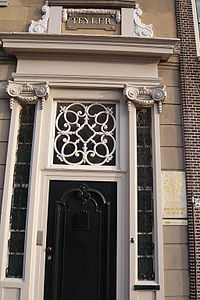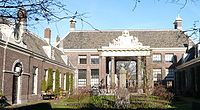
Pieter Teyler van der Hulst
Encyclopedia
Pieter Teyler van der Hulst (25 March 1702, Haarlem
– 8 April 1778, Haarlem) was a wealthy Dutch Mennonite
merchant, who died childless, leaving a legacy of two million florins to the pursuit of religion, arts and science in his hometown, that led to the formation of Teyler's Museum. This was not the value of his entire estate
. He also founded Teylers Hofje
in his name, and made important donations to individuals in the Mennonite community.


 Teyler was an active follower of the Scottish Enlightenment
Teyler was an active follower of the Scottish Enlightenment
, being descended from wealthy Scots merchants. His name is derived from the Scottish Tailor. He married the lady Helena Wynands Verschaave in 1728.He was an active member of the "Waterlander" mennonite community and became a trustee of the city orphanage from 1750 onwards. He made his wealth as a silk and cloth merchant, but from 1763 he became more and more active as a banker. He made loans to his Haarlem contemporaries, including to his fellow Scot and neighbor George Clifford III
, the wealthy Amsterdam merchant known for sponsoring Carl Linnaeus. Scottish bankers such as Teyler, Clifford, and Hope & Co.
were all patrons of the arts and sciences. Teyler was also active in the Haarlem Mennonite community with his wife, and together they founded a Mennonite hofje
in the Teyler name in 1752. Unlike other Mennonite hofjes of Haarlem, however, it was not necessary for its members to be Mennonites.
In the 18th century, the ruling classes of Amsterdam
(where Teyler had his banking offices) and Haarlem were all Protestants, as was the Dutch Stadtholder
. Roman Catholics, Mennonites, Quakers, and others were unable to participate in organisations such as the Dutch Society of Science (Hollandsche Maatschappij der Wetenschappen), which was started in Haarlem in 1752 with the purpose of pursuing science in all aspects. Ironically this society moved in 1831 across the Spaarne
river from Teyler's Museum, and has had close ties with Teyler's legacy ever since.
His former home in Haarlem with its entrance on the Damstraat is joined to the Teyler's Museum at the rear through a side door in the Oval room. Today his house is known as the "Fundatiehuis" and is open only by appointment and once a year on "Monumentendag".
Haarlem
Haarlem is a municipality and a city in the Netherlands. It is the capital of the province of North Holland, the northern half of Holland, which at one time was the most powerful of the seven provinces of the Dutch Republic...
– 8 April 1778, Haarlem) was a wealthy Dutch Mennonite
Mennonite
The Mennonites are a group of Christian Anabaptist denominations named after the Frisian Menno Simons , who, through his writings, articulated and thereby formalized the teachings of earlier Swiss founders...
merchant, who died childless, leaving a legacy of two million florins to the pursuit of religion, arts and science in his hometown, that led to the formation of Teyler's Museum. This was not the value of his entire estate
Will (law)
A will or testament is a legal declaration by which a person, the testator, names one or more persons to manage his/her estate and provides for the transfer of his/her property at death...
. He also founded Teylers Hofje
Teylers Hofje
The Teylershofje is a hofje in Haarlem, Netherlands with 24 houses.-History of the foundation:The current hofje was built in 1787 from the legacy of Pieter Teyler van der Hulst, just like the Teylers Museum close to it. Pieter Teyler van der Hulst originally founded a hofje when his wife died in...
in his name, and made important donations to individuals in the Mennonite community.
Biography



Scottish Enlightenment
The Scottish Enlightenment was the period in 18th century Scotland characterised by an outpouring of intellectual and scientific accomplishments. By 1750, Scots were among the most literate citizens of Europe, with an estimated 75% level of literacy...
, being descended from wealthy Scots merchants. His name is derived from the Scottish Tailor. He married the lady Helena Wynands Verschaave in 1728.He was an active member of the "Waterlander" mennonite community and became a trustee of the city orphanage from 1750 onwards. He made his wealth as a silk and cloth merchant, but from 1763 he became more and more active as a banker. He made loans to his Haarlem contemporaries, including to his fellow Scot and neighbor George Clifford III
George Clifford III
George Clifford III was a wealthy Dutch banker and one of the directors of the Dutch East India Company. He is known for his keen interest in plants and gardens...
, the wealthy Amsterdam merchant known for sponsoring Carl Linnaeus. Scottish bankers such as Teyler, Clifford, and Hope & Co.
Hope & Co.
Hope & Co. is the name of a famous Dutch bank that spanned two and a half centuries. Though the founders were Scotsmen, the bank was located in Amsterdam, and at the close of the 18th century it had offices in London as well.-Early days:...
were all patrons of the arts and sciences. Teyler was also active in the Haarlem Mennonite community with his wife, and together they founded a Mennonite hofje
Hofje
A hofje is a Dutch word for a courtyard with almshouses around it. They have existed since the Middle Ages.A hofje provided housing for elderly people . They were privately funded, and served as a form of social security...
in the Teyler name in 1752. Unlike other Mennonite hofjes of Haarlem, however, it was not necessary for its members to be Mennonites.
In the 18th century, the ruling classes of Amsterdam
Amsterdam
Amsterdam is the largest city and the capital of the Netherlands. The current position of Amsterdam as capital city of the Kingdom of the Netherlands is governed by the constitution of August 24, 1815 and its successors. Amsterdam has a population of 783,364 within city limits, an urban population...
(where Teyler had his banking offices) and Haarlem were all Protestants, as was the Dutch Stadtholder
Stadtholder
A Stadtholder A Stadtholder A Stadtholder (Dutch: stadhouder [], "steward" or "lieutenant", literally place holder, holding someones place, possibly a calque of German Statthalter, French lieutenant, or Middle Latin locum tenens...
. Roman Catholics, Mennonites, Quakers, and others were unable to participate in organisations such as the Dutch Society of Science (Hollandsche Maatschappij der Wetenschappen), which was started in Haarlem in 1752 with the purpose of pursuing science in all aspects. Ironically this society moved in 1831 across the Spaarne
Spaarne
The Spaarne is a river, in North Holland, Netherlands. This partially canalized river connects the Ringvaart to a side branch of the North Sea Canal. It runs through Haarlem, Heemstede, and Spaarndam....
river from Teyler's Museum, and has had close ties with Teyler's legacy ever since.
Legacy
His will and testament was written in 1756 after Teyler's wife died, only a few years after this science society was founded. The original terms in the Teyler will define a yearly science prize to be awarded by the keepers of his library, art and science collection. These 'keepers' became champions of art and science in their own right, periodically reinterpreting the will as befitted their purpose, resulting in a continuously changing charter that has led to the eclectic Teyler's Museum as it exists today. Under the will three societies were established, for religion, science, and art, which became known as the first, second and third societies.His former home in Haarlem with its entrance on the Damstraat is joined to the Teyler's Museum at the rear through a side door in the Oval room. Today his house is known as the "Fundatiehuis" and is open only by appointment and once a year on "Monumentendag".
External links
- Noord-Hollandsarchief Archives of North Holland
- Teylers Museum (in Dutch)
- Dutch Society of Science (in Dutch)

